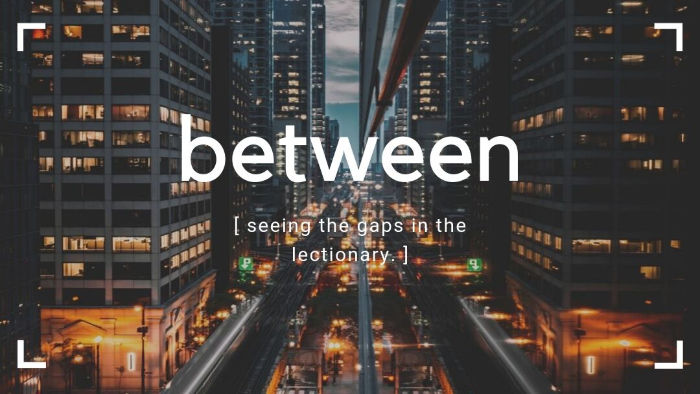A look at the gaps in the lectionary.
This week: the gap between Pentecost and Trinity Sunday
The text: switches from John to Matthew 28:16-20
For church nerds, we’re in the biggest moment of the church year. Yes, we all love Christmas and Easter. And also yes, Easter Day is now long in the rearview. I’m talking about the bonanza that is three principal feasts in three weeks.
Ten days ago, we had Ascension Day. Now Pentecost. Next is Trinity Sunday.
The fact that these feasts are overshadowed by the cultural colossus that is Christmas and the eagerness that is Easter makes the challenge for these feasts clear.
These three are also very “heady” feasts. Ascension Day: for its abstract departure necessity. Pentecost: for its Spiritual revival moment. Then, most abstract of all, Trinity Sunday: the day we celebrate a theological construct.
You would be forgiven if this isn’t your favorite holiday season.
The Second Part
The move from Pentecost to Trinity Sunday is dramatic in the lectionary, but perhaps less so in the imagination. In a practical sense, Trinity Sunday essentially exists as a “Part 2” of Pentecost.
What we get in the Sunday after the Ascension is instruction from Jesus about the coming of the Holy Spirit. Then, in Pentecost, the Spirit arrives. In Trinity Sunday, we have the opportunity to describe how the Spirit relates to Jesus and God.
In experiential terms we actually embody this transition. Our focus is almost always fixed on either Jesus, the Father, or both. So, when the Spirit makes this grand entrance on Pentecost, there’s a collective “oh, yeah…” quality to the moment. Like we forgot about the third person of the Trinity.
Outside of Pentecostal circles, Christians so rarely engage with the Holy Spirit, that we really do need Trinity Sunday to shake us up and remind us that our tradition has three persons in the Godhead, not just two.
Before the Great Commission
Of the four gospels, Matthew really understands the “get out” of the narrative part of storytelling: after the climax of the story, you need to resolve and get out quickly. Because we don’t want every loose end wrapped up. We want resolution and to be done.
Other than the brevity, what is unique about Matthew’s gospel is what he does obsess about.
Chapter 28 opens with the Resurrection appearance to Mary. Then it proceeds to focus on what the guards report to the chief priests about the empty tomb.
The guards, who witnessed the events (which are most dramatic in Matthew), have a lot to tell.
- An earthquake as an angel rolls the stone out of the way.
- The guards freeze “like dead men”.
- Then the angel speaks to the women at the tomb.
Then, Jesus appears to the women on their way to meet the disciples. But I suppose the guards didn’t witness this.
When the chief priests hear this, they consult with each other before deciding on paying the soldiers off.
Then the section ends, implying that this made-up story is still spread for this purpose.
What Matthew focuses on
This isn’t the first time Matthew has shown particular interest in how things look to the leaders and to the experience of the guards.
At the end of chapter 27, once Jesus is in the tomb, there is a discussion between the leaders and Pilate about Jesus’s claims that he will rise on the third day. They seem freaked out, like when you watch a horror movie and know that a creepy girl won’t climb out of the TV, but you put a blanket over it anyway so you can sleep better.
There’s a sense of belief/disbelief, not as a duality, but as something hazy and unstable. What we see is both a sense that the leaders don’t actually believe their own rhetoric, because they really want to be sure AND a sense that they don’t want to believe Jesus, but strangely kind of do.
Most responses to this gospel are straightforwardly focused on the author’s intent. That these shore up the sense of why there were people who actually doubted what happened. But this, too, is a bit of doth protesting too much.
It seems the point of their action is to discredit Jesus, not reveal the truth. They aren’t Truthers or journalists. They are defenders of the status quo.
Spreading Good News vs. Lies
This sets up an interesting argument in the last chapter or so of Matthew. That the Temple leaders are focused on spreading lies. And then, Jesus appears to his followers, and invites them to spread the Good News.
We can probably call it lies versus truth. But I think that is, perhaps, too simple by half.
Because Jesus isn’t focused on the truth in the abstract. He’s focused specifically on the Good News: that God is transforming us and the world. That our purpose is Shalom. We are restorers of health, peace, and justice to the world. That this is reflective of the truth.
On the flip side, we have the lies of the leaders, bent on protecting bad news. That we are stuck without health, peace, or justice in the world.
This isn’t an abstraction about truth, but a condemnation of a world order built around exploitation.
